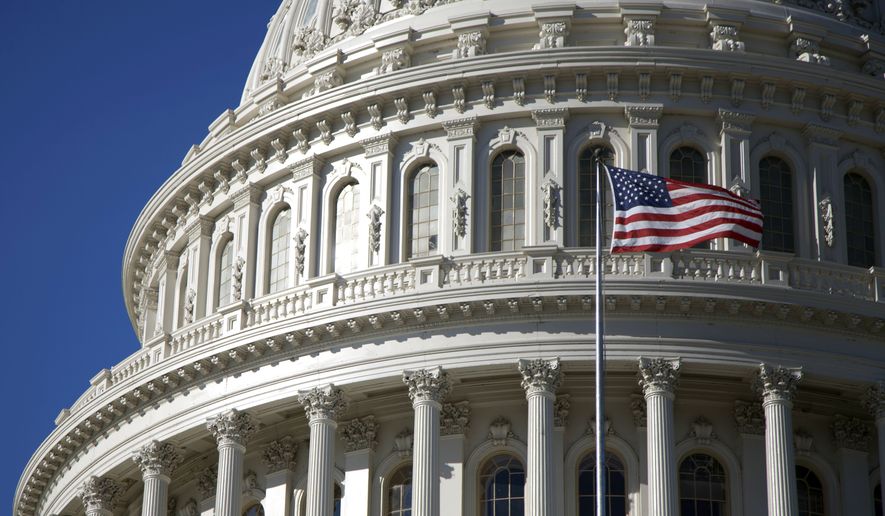U.S. Capitol Police shot and wounded a gunman Monday at a security checkpoint at the Capitol Visitor Center complex after he brandished a weapon.
“It appears that the screening process worked the way it was supposed to,” U.S. Capitol Police Chief Matthew Verderosa said during a brief afternoon news conference.
Delegate Eleanor Holmes Norton, the District of Columbia’s representative in Congress, praised the police force’s efficiency in dealing with a potentially deadly threat.
“The U.S. Capitol Police deserve tremendous credit for disposing of today’s shooting incident within an hour’s time through quick action and a shelter-in-place directive, which was lifted expeditiously after the suspect was taken into custody …,” Ms. Norton said in a statement. “The Capitol Police clearly showed they were prepared.”
Coming on the heels of terrorist attacks in Brussels and in Lahore, Pakistan, the incident occurred when many members of Congress were on recess but thousands of tourists had come to the nation’s capital to view its cherry blossoms and visit sites such as the Capitol. Chief Verderosa said thousands of people visit the Capitol every day and about 2 million are screened through the Visitor Center every year.
The police chief said the incident started about 2:39 p.m. Monday when a man entered the north screening facility of the Capitol Visitor Center, drew a weapon and pointed it at officers. An officer shot the man, who underwent surgery at Washington Hospital Center in Northwest. His condition was not known, the chief said.
No officers were injured, but a 35- to 45-year-old female bystander received minor injuries and was treated at a hospital, Chief Verderosa said without elaborating about her injury.
He said no charges had been filed but an investigation was continuing. Earlier reports that an officer had been shot were erroneous.
“We do believe this is an act of a single person who has frequented the Capitol grounds before, and there is no reason to believe that this is anything more than a criminal act,” the chief said.
Chief Verderosa declined to identify the suspect but said officers and bomb disposal specialists were examining his truck.
Several news organizations identified the man as Larry Dawson of Antioch, Tennessee. Mr. Dawson was arrested in October after disrupting a session of the House by yelling that he was a “prophet of God,” and reports said he assaulted an officer on the House balcony. Mr. Dawson was charged with assault, and D.C. Superior Court ordered him to stay away from the Capitol.
The incident prompted a one-hour lockdown at the Capitol, and staffers were directed to shelter in place until the situation was resolved. The Capitol’s east plaza filled with police vehicles as the intercom system blared a warning about shots fired. The White House also was locked down briefly.
The Visitor Center remained closed pending completion of the investigation. Chief Verderosa said the center would reopen Tuesday.
Unlike the White House, where access is more strictly controlled, the Capitol is open to the general public for regular tours.
Calls for more security at the Capitol arose after two Capitol Police officers were killed by a single gunman in 1998. Russell Eugene Weston, who was suffering from mental illness, gunned down Officers John Gibson and Jacob Chestnut in the building. Those calls grew louder after the Sept. 11, 2001, attacks on New York City and the Pentagon.
Opened in 2008, the Visitor Center is a complex of meeting rooms, exhibits and a cafeteria. It was built in part to screen visitors to prevent danger from reaching the interior of the main building. All visitors are required to go through metal detectors and have their bags screened.
“Today we are reminded of the courage and daily sacrifice of the United States Capitol Police,” House Speaker Paul D. Ryan said in a statement. “The Capitol is our greatest symbol of democracy, and these officers serve to protect not just those who work there but also the millions of visitors from all around the world who travel each year to see it.”
The Capitol complex has always been a target, but security has come a long way since 1954, when four Puerto Rican nationalists opened fire from the visitor’s gallery in the House of Representatives chamber, said Anthony Roman, a counterterrorism security analyst.
“It’s unlikely today that what happened in the ’50s could happen again,” Mr. Roman said.
Now, the Capitol has constant video and human surveillance, a series of concentric security zones for visitors and more heavily armed police officers, he said.
The incident Monday happened in the Visitor Center’s outermost security zone, where people are screened with X-ray machines, Mr. Roman said. Visitors must pass through several other zones and security checkpoints as they move toward the building and the chambers for members of Congress.
Cameras are placed at each zone, and Capitol personnel must accompany all visitors, Mr. Roman said. Even if someone was able to get a weapon through the first ring of security, he said, it would be difficult to avoid detection beyond that point.
The Capitol complex is under even heavier security with thousands of tourists in town for the Cherry Blossom Festival.
“Anytime you expect larger numbers of tourists, the potential for an active threat goes up simply because you have many, many more people to watch,” Mr. Roman said.
⦁ Stephen Dinan contributed to this article, which is based in part on wire service reports.
• Ryan M. McDermott can be reached at rmcdermott@washingtontimes.com.




Please read our comment policy before commenting.